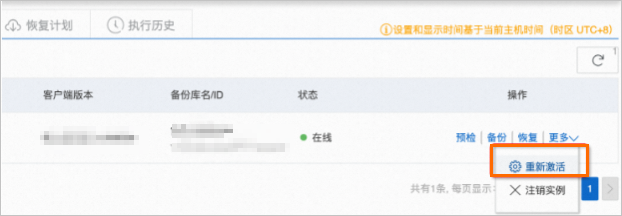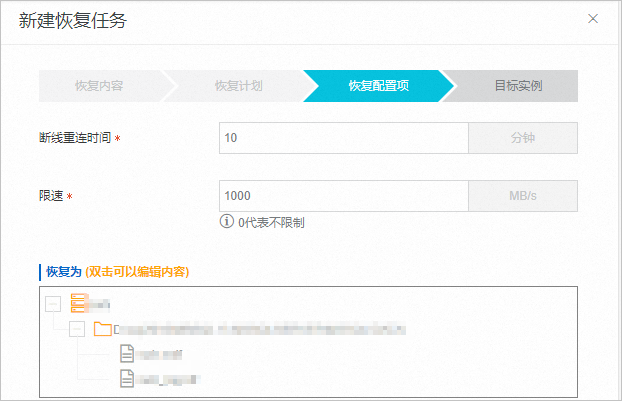本文為您介紹Cloud Backup使用中Database Backup常見的問題以及對應的解決辦法。
MySQL資料庫執行個體狀態顯示為未激活,如何處理?

您註冊資料庫時輸入的数据库用户名不正確、許可權不足或者密码錯誤,確認使用者名稱和密碼正確後,請為該備份帳號添加足夠的許可權。建議您建立專門用於備份的使用者。
該使用者所具備的最小許可權集為RELOAD、LOCK TABLES、REPLICATION、PROCESS。
您可以執行
systemctl status dbackup3-agent查看備份用戶端的進程狀態。其中active表示用戶端運行正常。● dbackup3-agent.service - dbackup3 agent daemon Loaded: loaded (/usr/lib/systemd/system/dbackup3-agent.service; enabled; vendor preset: disabled) Active: active (running) since Mon 2023-12-11 13:47:34 CST; 1min 13s ago Main PID: 22192 (dbackup3-agent) CGroup: /system.slice/dbackup3-agent.service └─22192 /opt/scutech/dbackup3/bin/dbackup3-agent -f /etc/opt/scutech/dbackup3/agent/svc.conf.d Dec 11 13:47:34 iZbp1******gktZ systemd[1]: Started dbackup3 agent daemon.用戶端日誌路徑位於:
/var/log/dbackup3/agent.log
如果資料庫執行個體狀態顯示為“数据库离线”,該如何處理?

MySQL
查詢MySQL資料庫狀態。
請登入ECS執行個體,使用
systemctl status mysqld命令查詢MySQL資料庫狀態,發現其進程為inactive狀態,表示MySQL資料庫服務未啟動。重啟MySQL服務。
執行
systemctl start mysqld命令重啟MySQL服務後,控制台上的資料庫狀態顯示為在线。
Oracle
查詢Oracle資料庫監聽狀態。
登入ECS執行個體,執行如下命令:
su - oracle lsnrctl status當服務已啟動時,其狀態顯示為running;若服務未啟動,則會看到TNS: no listener的提示。
查詢Oracle資料庫運行狀態。
su - oracle sqlplus /nolog conn /as sysdba SELECT name, status FROM v$instance;v$instance視圖提供了資料庫執行個體的相關資訊,其中status列顯示執行個體的狀態。如果狀態為OPEN,表示資料庫當前已經開啟並且可以接受串連。
重啟Oracle監聽器。
啟動Oracle監聽器服務,監聽來自用戶端的串連請求。
su - oracle lsnrctl start重啟Oracle資料庫執行個體。
在SQL*Plus中,使用系統管理員身份登入,然後啟動Oracle執行個體。
sqlplus / as sysdba; STARTUP;啟動後,控制台上的資料庫狀態顯示為在线。
SQL Server
查詢SQL Server資料庫狀態。
按下
Win + R鍵開啟“運行”對話方塊。輸入
services.msc並按斷行符號鍵,開啟服務管理介面。在服務列表中找到SQL Server服務。例如“SQL Server (MSSQLSERVER)”。
查看服務狀態,可能顯示為“正在運行”、“已停止”或“暫停”。
重啟SQL Server服務。
如果SQL Server資料庫狀態為“已停止”或“暫停”,按右鍵SQL Server服務,選擇“啟動”。如果“啟動”選項呈灰色,建議您以管理員身份重新開啟服務管理員,然後重試一次。啟動後,控制台上的資料庫狀態顯示為在线。
僅查看離線執行個體功能說明
僅查看離線執行個體功能適用於以下情境:當安裝用戶端的機器重裝系統,或用戶端進程和配置被惡意程式刪除時,已安裝的用戶端將無法與原執行個體的服務端建立串連,從而無法恢複之前的備份資料。在這些情況下,例如重裝系統後安裝了新的用戶端,系統會分配不同的執行個體ID來區分新的用戶端和已離線的用戶端,確保不會產生混淆。您可將已離線執行個體上的資料恢複到安裝了新用戶端的執行個體上。恢複步驟,請參見恢複MySQL、恢複Oracle、恢複SQL Server。
如何查看用戶端的進程狀態,日誌路徑,以及如何重啟用戶端?
對於Linux系統:
查看備份用戶端的進程狀態。
您可以執行
systemctl status dbackup3-agent或service dbackup3-agent status查看Database Backup用戶端的進程狀態。其中active或dbackup3-agent is running...表示用戶端運行正常。● dbackup3-agent.service - dbackup3 agent daemon Loaded: loaded (/usr/lib/systemd/system/dbackup3-agent.service; enabled; vendor preset: disabled) Active: active (running) since Mon 2023-12-11 13:47:34 CST; 1min 13s ago Main PID: 22192 (dbackup3-agent) CGroup: /system.slice/dbackup3-agent.service └─22192 /opt/scutech/dbackup3/bin/dbackup3-agent -f /etc/opt/scutech/dbackup3/agent/svc.conf.d Dec 11 13:47:34 iZbp1******gktZ systemd[1]: Started dbackup3 agent daemon.重啟備份用戶端。
執行
systemctl restart dbackup3-agent或service dbackup3-agent restart命令重啟用戶端進程後,當控制台上資料庫用戶端狀態顯示為已安裝,則表明用戶端狀態已恢複正常。
用戶端日誌路徑位於:
/var/log/dbackup3/agent.log對於Windows系統:
按下
Win + R鍵開啟“運行”對話方塊。輸入
services.msc並按斷行符號鍵,開啟服務管理介面。在服務列表中找到
dbackup3-agent服務。檢查該服務的狀態是否為“正在運行”。如果狀態不是“正在運行”,則按右鍵
dbackup3-agent服務,並選擇“重新啟動”來啟動它。
用戶端日誌路徑位於:
C:\ProgramData\scutech\dbackup3\agent\log\dbackup3-agent.log
在控制台,資料庫用戶端狀態顯示為離線,該如何處理?
問題現象
資料庫用戶端狀態顯示為離線。

問題原因
當用戶端狀態顯示為離線時,表示雲備份未能接收到用戶端進程的心跳訊號。這種情況可能由多種原因造成,比如用戶端因記憶體不足而被自動終止,或是用戶端所在的裝置已關機等。
解決方案
您可以通過如何查看用戶端的進程狀態,日誌路徑,以及如何重啟用戶端?確認用戶端的狀態,然後重新啟動用戶端。當用戶端狀態顯示為運行中時,請稍作等待。當控制台上資料庫用戶端狀態顯示為已安裝,則表明用戶端狀態已恢複正常。
支援備份的MySQL資料庫版本、作業系統是否有限制?
支援的資料庫版本、作業系統和備份功能有限制,例如不支援部署在Windows中的MySQL資料庫。更多資訊,請參見相容系統列表和使用限制。
Database Backup庫的到期資料清理機制是怎樣的?
增量備份、累計增量備份和記錄備份依賴完整的前序備份鏈,包括前序的全量備份以及增量備份、累計增量備份、記錄備份。在包含全量+增量、累計增量、記錄備份的備份鏈中,最後一個備份到期前,完整備份鏈依賴的備份都會保留在備份庫中,佔用備份空間。請合理配置備份周期和到期時間。
例如,您9月1號做了全量備份,2號到7號每天做了一次增量,備份保留時間為7天。那麼9月1號到7號的7次備份資料,會等到9月14號資料全部到期後,才會自動刪除。
如何查看Database Backup資料量和備份庫使用量?計費依據是哪個?
备份数据量代表備份任務累計的資料量,比如1TB檔案備份兩次後,雲備份會儲存兩份獨立資料拷貝,此數值就計為2TB。Cloud Backup使用重刪壓縮技術縮減備份庫使用量,為您節省費用。實際佔用的备份库使用量是計費的依據。您可以在控制台概览頁面,查看存放庫備份資料量和備份庫使用量。
如何取消Database Backup?
如何取消MySQLDatabase Backup?
如何取消OracleDatabase Backup?
如何取消SQL ServerDatabase Backup?
在MySQL中新建立了一個資料庫,如何備份這個新庫?
MySQL備份按照資料庫執行個體進行備份,新增資料庫不需要您手動設定,下次備份會自動備份新增庫。
Database Backup失敗怎麼辦?
資料庫恢複失敗怎麼辦?
什麼是Database Backup庫
在建立Database Backup計劃前,您必須建立Database Backup庫。
Database Backup庫,即為儲存您Database Backup資料的儲存容量庫。Database Backup的費用由倉庫租用費、存放庫容量共同決定。更多資訊,請參見計費方式與計費項目。
備份SQL Server 2019時出現瀏覽資料庫詳情失敗如何處理?
問題分析:當備份SQL Server 2019時,如果有其他備份軟體或指令碼同時進行備份操作,那麼在建立或編輯備份計劃,並且選擇資料庫執行個體時,可能會出現瀏覽資料庫詳情失敗的情況。

解決方案:
在SQL Server資料庫中查詢有多少資料庫和備份組。
select count(database_id) from master.sys.databases select count(backup_set_id) from msdb.dbo.backupset刪除 msdb.dbo.backupset 中的備份記錄。
重要刪除備份記錄會對您造成影響,如果您有自己的備份,會導致備份記錄被清除,並且不能按照正常流程來恢複這些記錄。但是這不會影響到您的資料備份,因為在下一次備份的時候,它會自動轉換為全量備份。需要注意的是,在備份SQL Server 2019時不支援與其他備份軟體或指令碼同時使用。
use msdb; exec sp_delete_backuphistory @oldest_date = '04/10/2024' ---保留4/10,4/9之前都刪,您需要確認保留時間
在控制台,SQL Server資料庫執行個體狀態顯示為未激活,如何處理?

您註冊資料庫時輸入的数据库用户名不正確、許可權不足或者密码錯誤。請確認使用者名稱和密碼正確後,為該備份帳號添加足夠的許可權。建議您建立專門用於備份的使用者,然後重試。
請參見備份SQL Server準備工作頁面的操作步驟,建立SQL Server備份帳號和配置許可權。具體操作,請參見步驟二:建立備份帳號和配置許可權和步驟三:配置網路。
重啟
dbackup3-agent服務。按下
Win + R鍵開啟“運行”對話方塊。輸入
services.msc並按斷行符號鍵,開啟服務管理介面。在服務列表中找到
dbackup3-agent服務。檢查該服務的狀態是否為“正在運行”。如果狀態不是“正在運行”,則按右鍵
dbackup3-agent服務,並選擇“重新啟動”來啟動它。
重啟服務後如果仍然未能啟用,建議收集相關日誌以便進行進一步的分析,用戶端日誌路徑位於:
本地磁碟(C)> ProgramData > scutech > dbackup3 > agent > log > dbackup3-agent.log。
如何更換Database Backup使用的使用者名稱和密碼?
在備份整個過程中,可以通過重新激活來更換備份使用的使用者名稱和密碼,例如密碼到期。重新啟用,對現有的備份計劃沒有影響,無需改變備份計劃。但是對正在執行中的備份任務有影響。建議:
在備份計劃頁簽先暫停(如有)即時記錄備份;
在對應資料庫的操作列,選擇更多>重新激活。
備份本地SQL Server資料庫安裝備份用戶端報錯Failed to run install script:exit status 4如何處理?
電腦本地安全設定策略項(用於內建管理員賬戶的管理員核准模式)未啟用,該策略狀態必須為已啟用。
Win+R開啟運行命令,輸入
gpedit.msc,運行本機群組原則編輯器。在本機群組原則編輯器面板,依次選擇電腦配置 > Windows設定 > 安全設定 > 本地策略 > 安全選項,在右側找到使用者帳號控制:用於內建管理員賬戶的管理員核准模式,將該策略狀態修改為已啟用。
註冊資料庫執行個體後,ECS資料庫執行個體頁簽出現多條資料庫執行個體,是為什嗎?
如果一台ECS上部署了多個資料庫執行個體,雲備份控制台會在註冊環節將其全部掃描並展示出來。

為什麼收到警示的時間和實際錯誤發生時間不一致?
簡訊警示設定了夜間抑制功能,將晚上8點至次日早上8點期間觸發的警示延遲至早上8點之後發送;而郵件警示則不受此限制,會即時發送。
為什麼備份歷史中有一些重複的,或者非預期時間執行的記錄?
這種情況通常是在安裝了Database Backup用戶端的伺服器(本機伺服器或ECS)被複製時發生,或使用包含同一備份用戶端的鏡像建立新的ECS或本機伺服器時發生的。由於複製後的伺服器保留了原伺服器上用戶端的部分資訊,因此可能會產生重複的備份記錄。為瞭解決這一問題,您只需要登入到複製後的伺服器,並執行卸載操作即可。關於如何卸載備份用戶端,請參照以下步驟:
為什麼收到警示失敗的郵件或簡訊,但是查看備份歷史發現同一時間會有備份成功和備份失敗的兩條記錄?
這種情況通常是在安裝了Database Backup用戶端的伺服器(本機伺服器或ECS)被複製時發生,或使用包含同一備份用戶端的鏡像建立新的ECS或本機伺服器時發生的。由於複製後的伺服器保留了原伺服器上用戶端的部分資訊,因此可能會產生重複的備份記錄。為瞭解決這一問題,您只需要登入到複製後的伺服器,並執行卸載操作即可。關於如何卸載備份用戶端,請參照以下步驟:
為什麼備份失敗且備份計劃的狀態顯示為“錯誤”?

如果遇到備份計劃狀態顯示為“錯誤”且備份失敗的情況,請您首先檢查安裝了用戶端的伺服器(本機伺服器或ECS)是否執行過鏡像複製、重新安裝作業系統或重設系統硬碟等操作。這些操作可能會導致備份計劃與用戶端之間的關聯失效。為瞭解決這一問題,請參照以下步驟:
確保已經卸載了複製伺服器上的用戶端及其設定檔。具體操作,請參見卸載用戶端。
確保當前伺服器上的用戶端狀態為已安裝。

在完成上述步驟後,通過控制台刪除原有的備份計劃,並建立一個新的備份計劃。
為什麼Database Backup註冊執行個體失敗?
請先確認當前伺服器(本機伺服器或ECS)上是否已安裝過Database Backup用戶端。如果已安裝,請參照卸載用戶端,卸載Database Backup用戶端並清理相關設定檔,然後重新嘗試註冊執行個體。
本機資料庫備份如何免費試用?
本機資料庫備份與ECSDatabase Backup的免費試用方式是相同的。免費試用詳情,請參考30天免費試用說明。
即時備份的最小間隔是多少?可以和增量備份同時配置嗎?
即時備份理論上可以達到秒級的RPO,目前主要支援MySQL和Oracle資料庫。啟用即時備份後,雖然不能再單獨配置傳統的記錄備份,但仍然可以與增量備份結合使用,以進一步增強資料保護策略。
本機資料庫備份對網路的要求是什麼樣子的?
本機資料庫伺服器的網路已經通過專線或者VPN和阿里雲Virtual Private Cloud及路由(線下到雲上100.64.0.0/10或100.64.0.0/11、100.96.0.0/11)互連。
ECSDatabase Backup用戶端安裝失敗如何解決?
為了確保ECSDatabase Backup用戶端的成功安裝,請首先確認雲助手已經正確安裝並處於正常運行狀態。如果遇到安裝失敗的情況,通常可以在雲助手控制台找到一條失敗的命令記錄。此時,建議您將該條命令複製並在您的ECS主機上手動執行。在手動安裝過程中,如遇網路連接問題或系統指令碼執行錯誤,螢幕上將會顯示具體的錯誤資訊。請根據這些提示解決相關問題(例如調整網路設定等)。一旦解決了所有問題並且指令碼能順利完成執行,就表明用戶端已成功安裝。最後,在控制台再次觸發一次安裝操作以完成整個過程。
在ECS執行個體從原帳號轉移到新的阿里雲帳號之後,若發現無法正常安裝或使用Database Backup功能,該如何解決?
當ECS執行個體從原帳號轉移到新的阿里雲帳號後,ECS中繼資料資訊不會自動同步至雲備份服務,需要先在雲備份服務後台完成同步,之後再進行安裝和使用。具體操作步驟,建議您聯絡“雲備份支援”或加入DingTalk群組“雲備份線上諮詢”擷取協助。
Cloud Backup支援人員群
快速諮詢費用、功能和使用等問題。點擊加入雲備份線上諮詢(建議使用Chrome開啟)。請搜尋公開群組並加入,DingTalk群號:88650005148。
Cloud Backup專家支援
技術專家現場分析,快速解決產品問題。點擊聯絡雲備份支援(建議使用Chrome開啟)。請添加DingTalk好友,DingTalk號:d37_g935gslgo。


